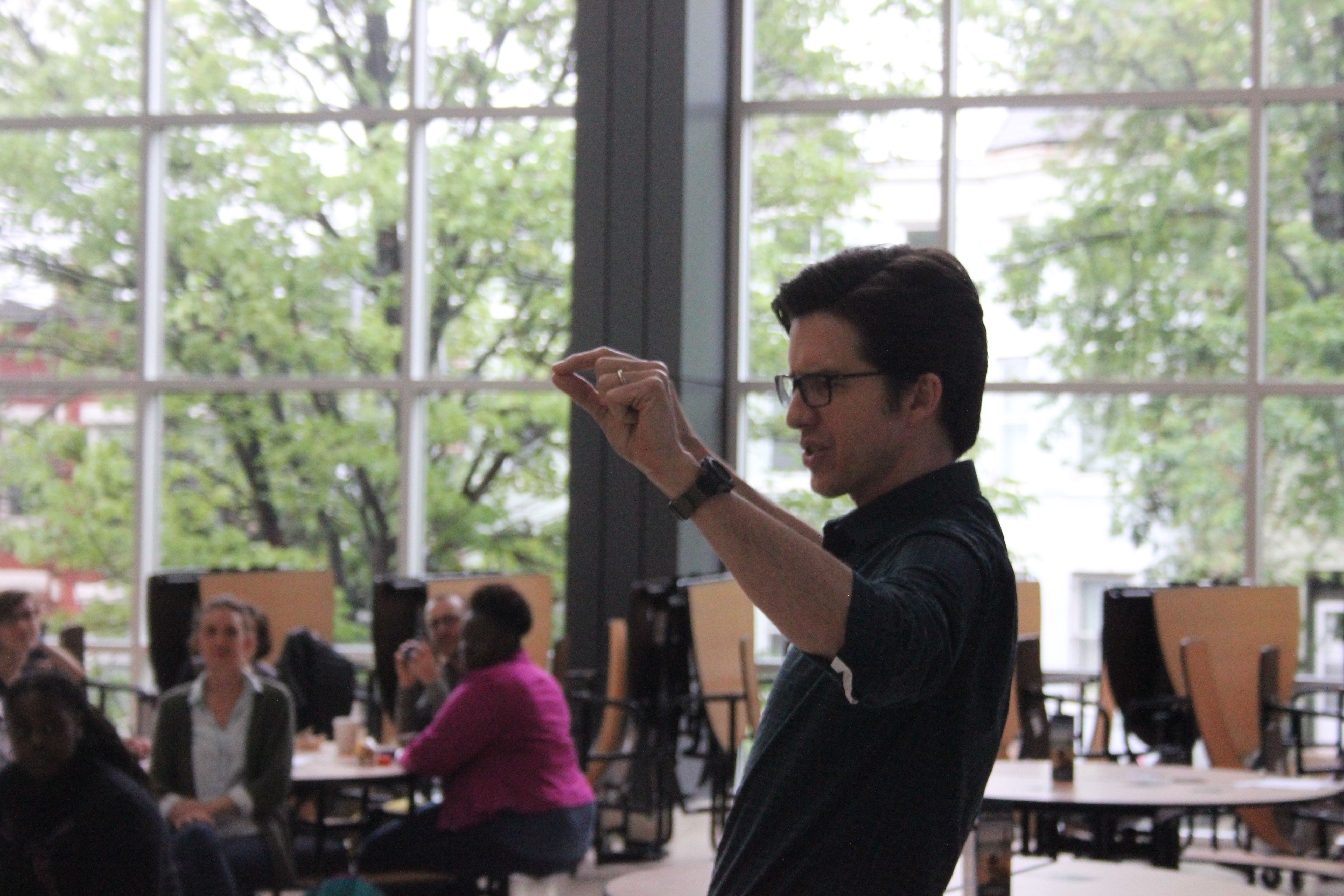Pulitzer Center staff and grantees presented professional development workshops for nearly 100 DC Public School (DCPS) visual arts and social studies teachers at Dunbar and McKinley Tech High Schools on Friday, May 6, 2016.
The workshops, organized by Pulitzer Center’s Senior Education Manager Fareed Mostoufi, introduced educators to the Center’s Lesson Builder and engaged them in discussion about how Pulitzer Center resources and journalists could support the work they are doing in their classrooms.
The professional development day at Dunbar High School for visual arts teachers began the same way many schools start their days, with ample coffee and a roaring buzz of conversation.
The introduction session had run late, the 75 visual arts teachers were sitting with teachers from all grade levels, and they appeared puzzled at the first question they were asked to discuss: “What is the first word that comes to mind when you think of Africa?”
Their presenter was Pulitzer Center journalist Austin Merrill, who co-founded photography project Everyday Africa and with Peter DiCampo to combat misperceptions of the continent. Merrill had traveled from New York City to present a new middle school unit plan written in collaboration between DCPS and Pulitzer Center using the Center’s Lesson Builder that focuses on photography skills and the role photography can play in encouraging perceptions of a community. The Everyday DC unit plan will be part of the DCPS visual arts curriculum next year.
“Conflict,” one teacher responded.
“Poverty,” another added.
“Hunger. AIDS. The Lion King,” others added.
Merrill presented the teachers with a word cloud representing how a group of students in Mombasa, Kenya responded when he asked them what they think of when they hear the word ‘Africa.’ The most common answers were culture, diversity and wildlife.
As the founders explain it on their website, "Everyday Africa, a collection of images shot on mobile phones across the continent, is an attempt to re-direct focus toward a more accurate understanding of what the majority of Africans experience on a day-to-day basis: normal life. The project is a response to the common media portrayal of the African continent as a place consumed by war, poverty, and disease."
Merrill explained to the teachers at the workshop why young students connect to Everyday Africa. First, it was born and continues to thrive on Instagram, a platform almost all students are obsessed with. The project has also led to discussions about how students can contribute to creating more accurate representations of their communities.. Merrill explained that the "Everyday" movement has been picked up all around the world, and has been incorporated into several classrooms in the US. The Everyday Bronx page on Instagram is still running today.
The teachers began walking through parts of an “Everyday Africa unit plan by talking about the difference between what people think of DC and what life in DC is actually like. Ben’s Chili Bowl, chicken wings with mambo sauce, public art and playgrounds are things they said they would photograph if they were posting to an Instagram page documenting “Everyday DC.” They then discussed the photography skills students would learn as part of the lesson, and practiced those skills by photographing each other and their surroundings.
The unit was written for middle school, but as Merrill and Mostoufi pointed out, it can easily be adapted for any grade level. The teachers left the panel excited about the possibility of working with the Pulitzer Center, visibly shown when nearly everyone raised their hands, saying that they would try the new unit next year. Some even offered to be part of a group of teachers who would write and beta test new lessons.
At McKinley Tech, grantee Oren Rudavsky discussed the benefits and challenges of teaching the Israeli-Palestinian Conflict to students, explaining that Pulitzer Center resources can provide the much needed context lacking in many textbooks.
Rudavsky screened two clips from his film “Colliding Dreams” about the history of Zionism and the Middle East conflict. He was invited by the social studies department at DCPS to provide context for a 10th grade World History standard that asks students to describe the process and impacts of Israel’s establishment after World War II.
“We’re trying to give both narratives their due and maybe that leads to conflict in the classroom--or conversation,” Rudavsky said, addressing a teacher’s earlier concern that if she doesn’t “tread lightly” over the topic, she may offend students with strong ties to the conflict.
At the conclusion of both clips, Rudavsky asked the 18 teachers in attendance how they would use the film in their classrooms. One teacher said the film could help students contextualize the Holocaust. Another said the clips give students the opportunity to make connections between the ways Jews were treated in Eastern Europe and the ways African Americans were treated in the South with Jim Crow laws.
Giving unsolicited testimony to the good work that Pulitzer Center lessons and grantees do in the classroom, one teacher attending the Visual Arts professional development workshop, Carmen Jenkins Frazier, an art teacher at the School Without Walls at Francis Stevens, said she brought in a journalist to talk to her students last month and implored the other teachers to do so as well. She could not believe how captivated the students were when the journalist was talking and how willing they were to ask questions—a rarity when the risk of embarrassing themselves can quash curiosity in children.
“Please, please use this free resource," she concluded. "It's free!"













